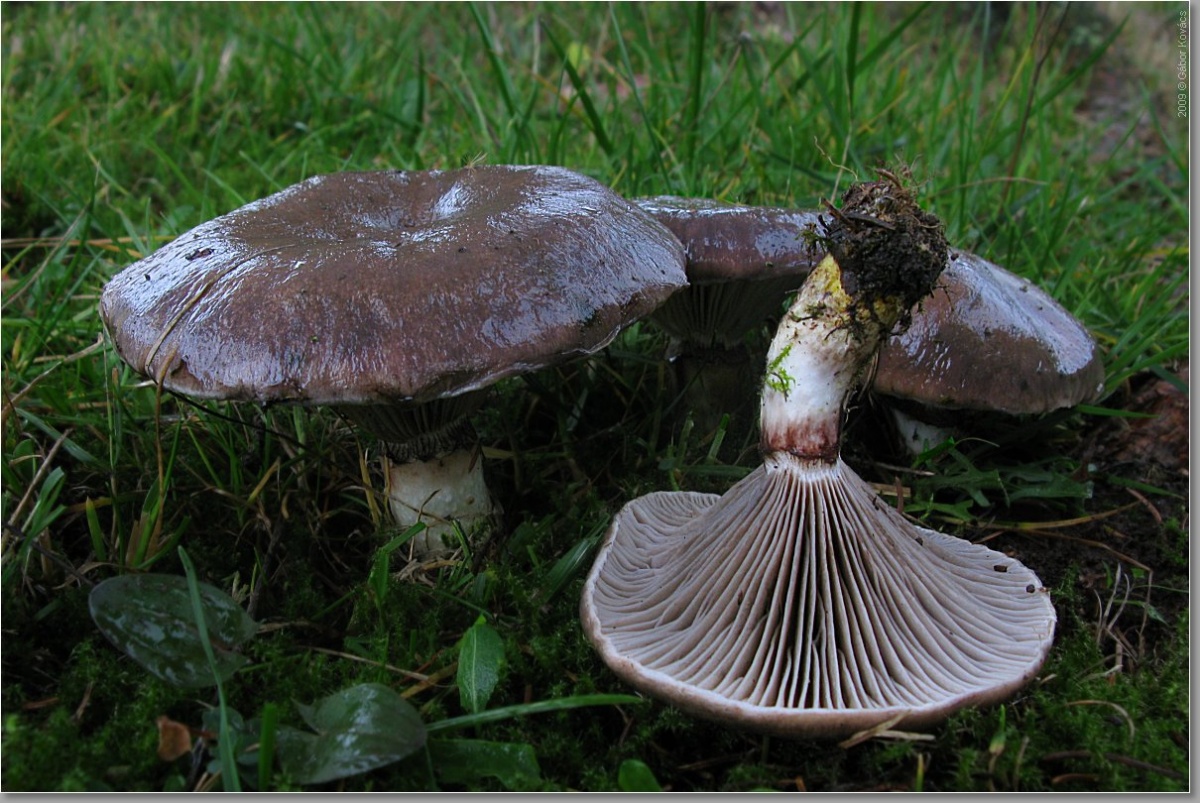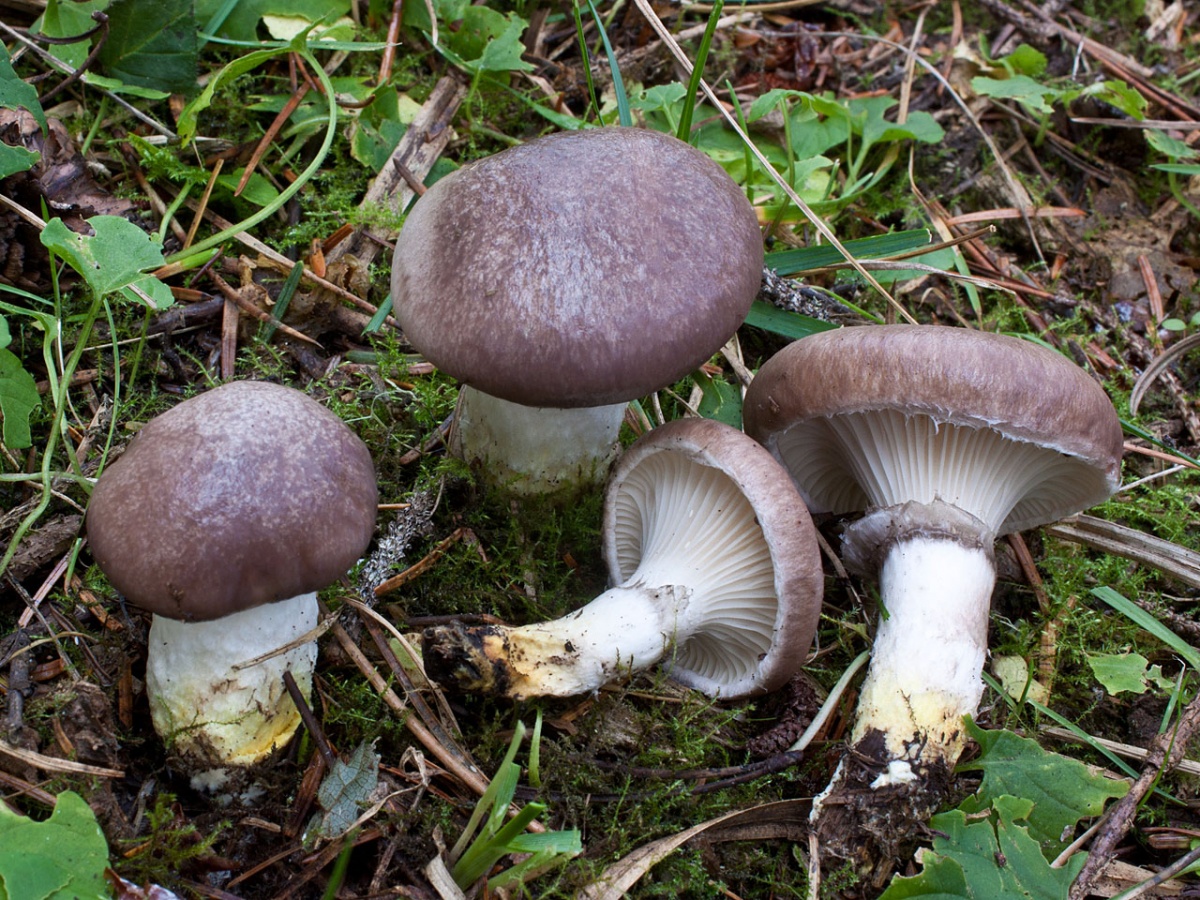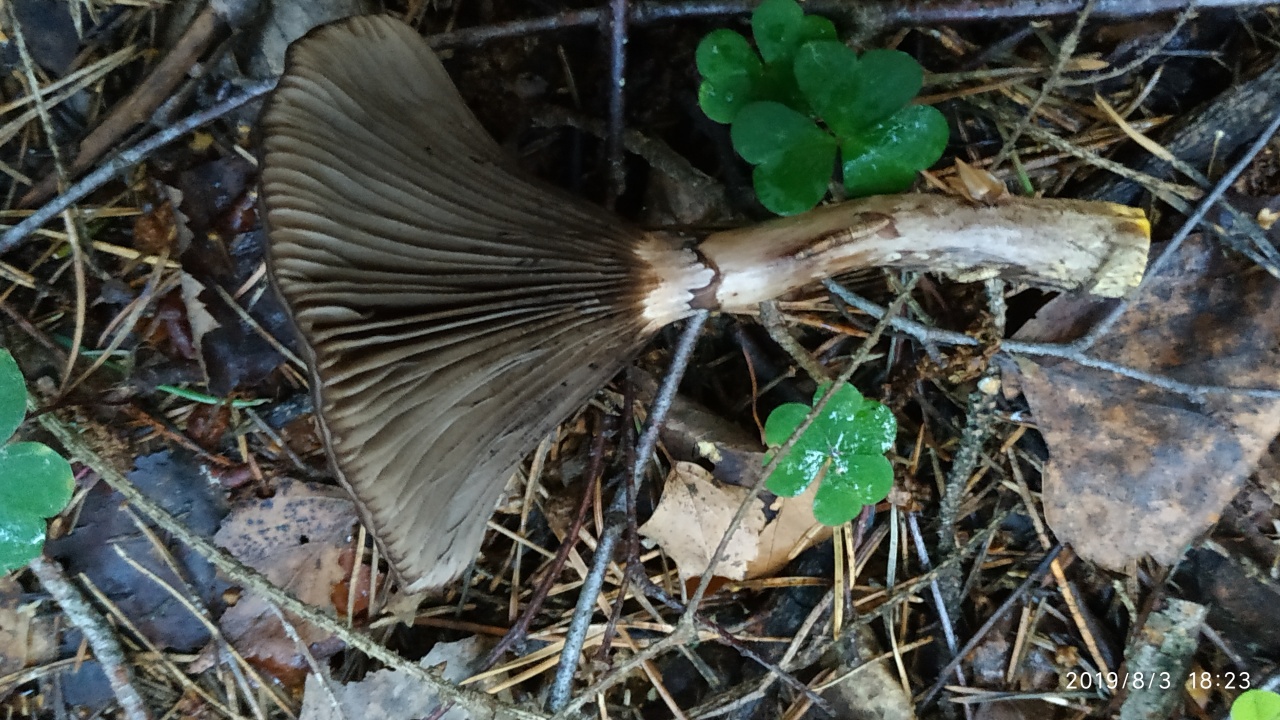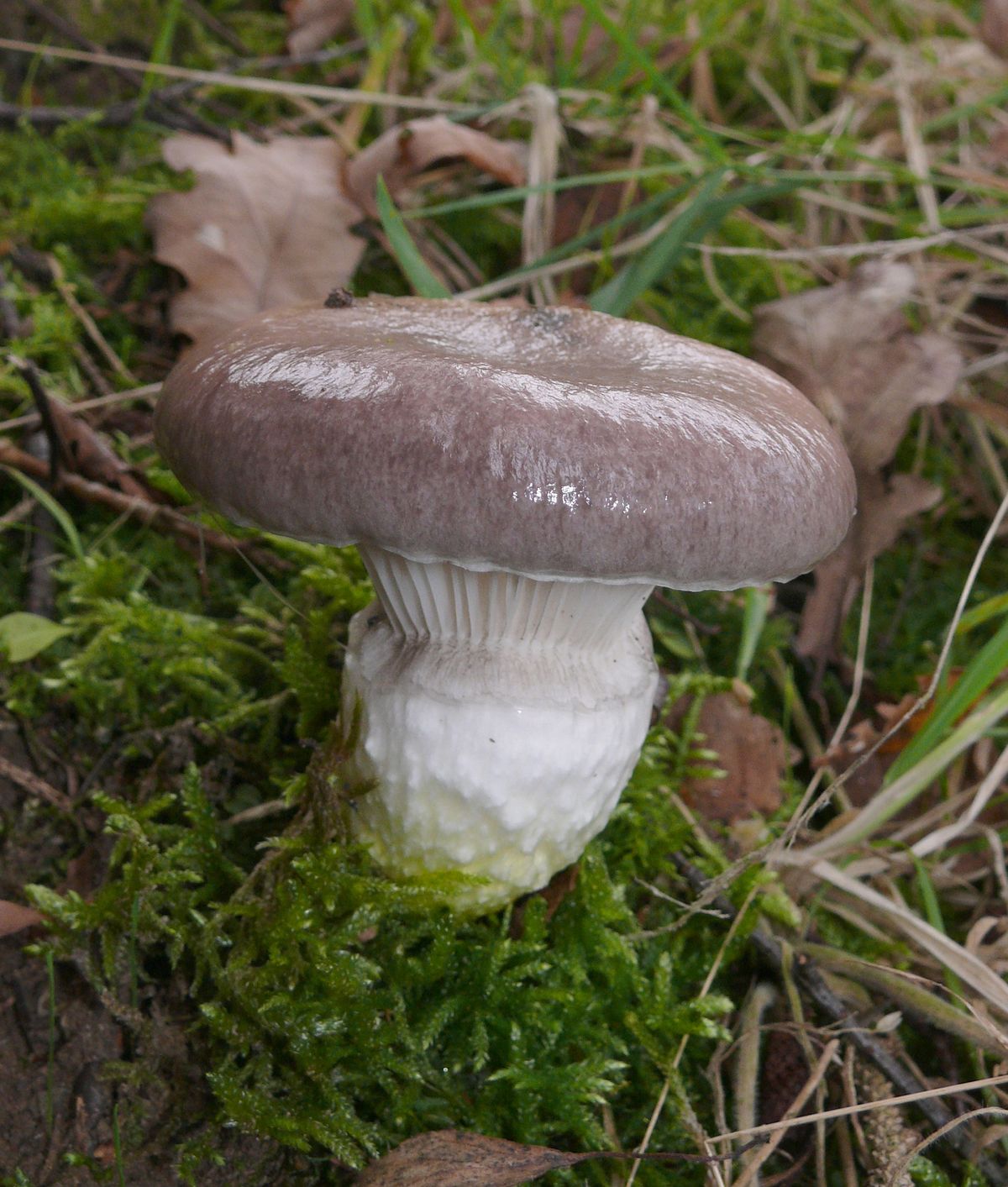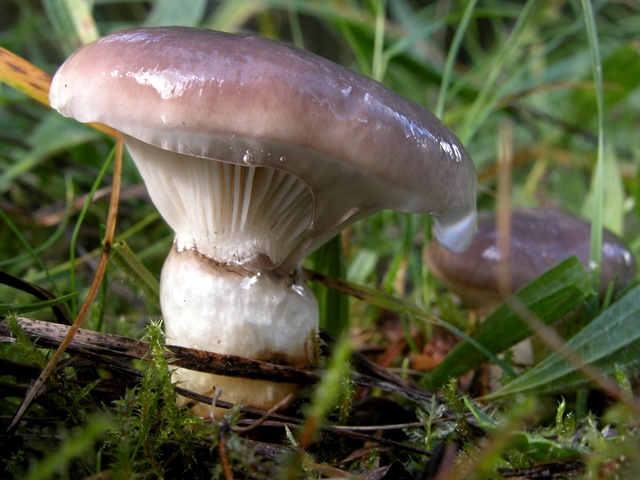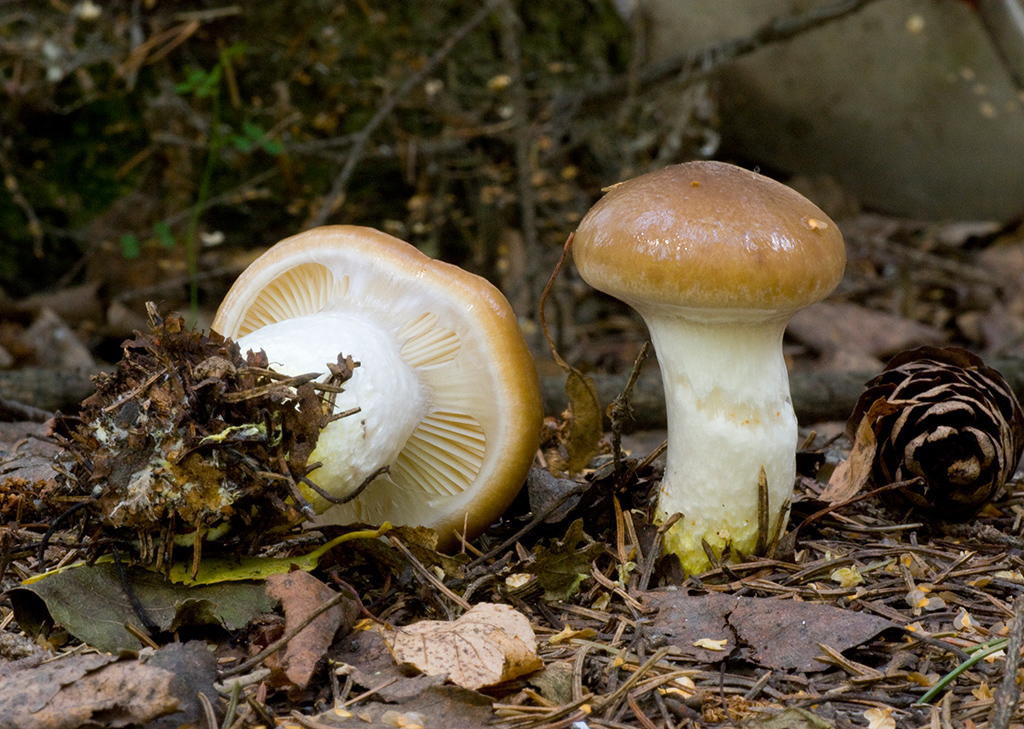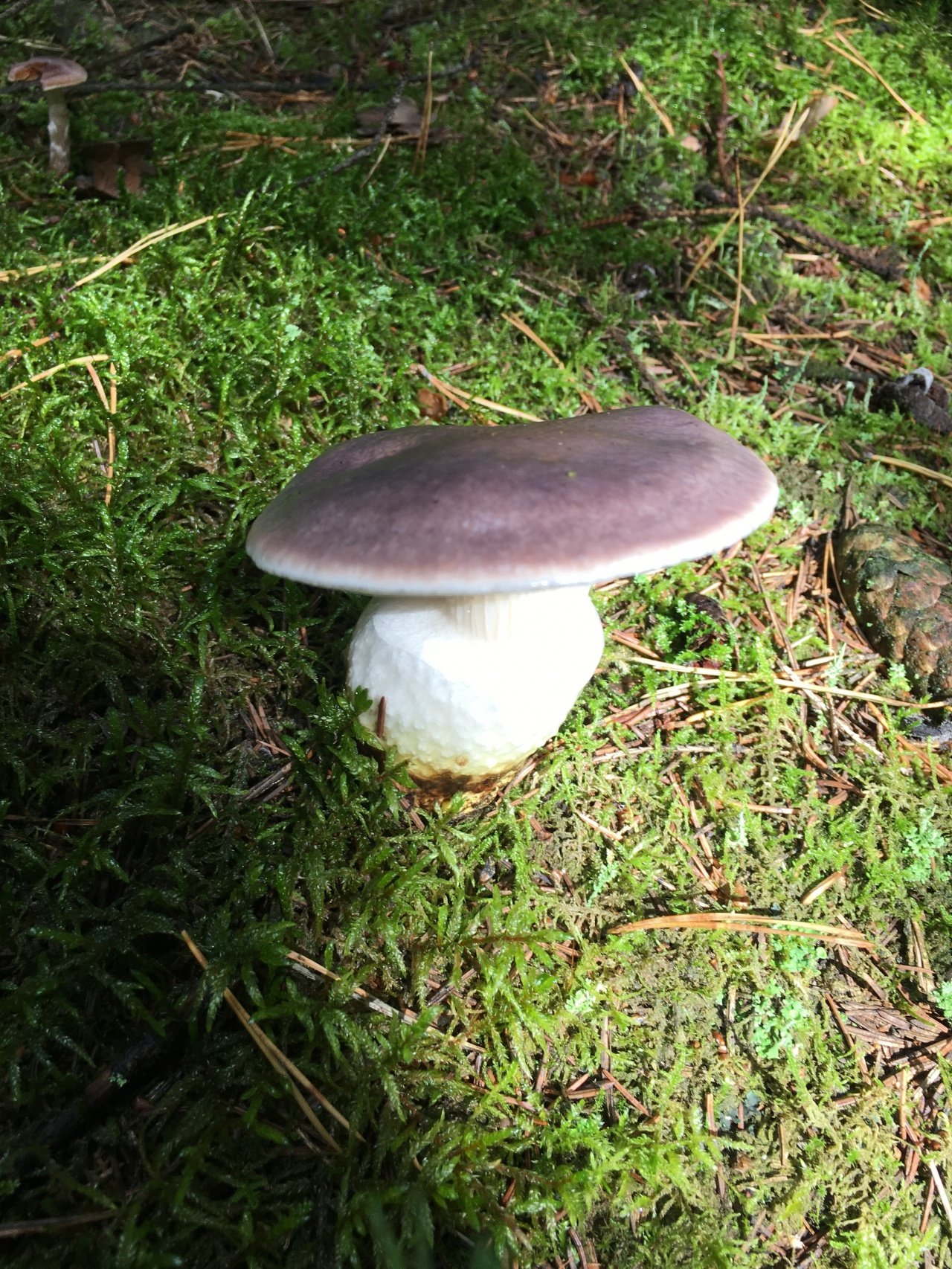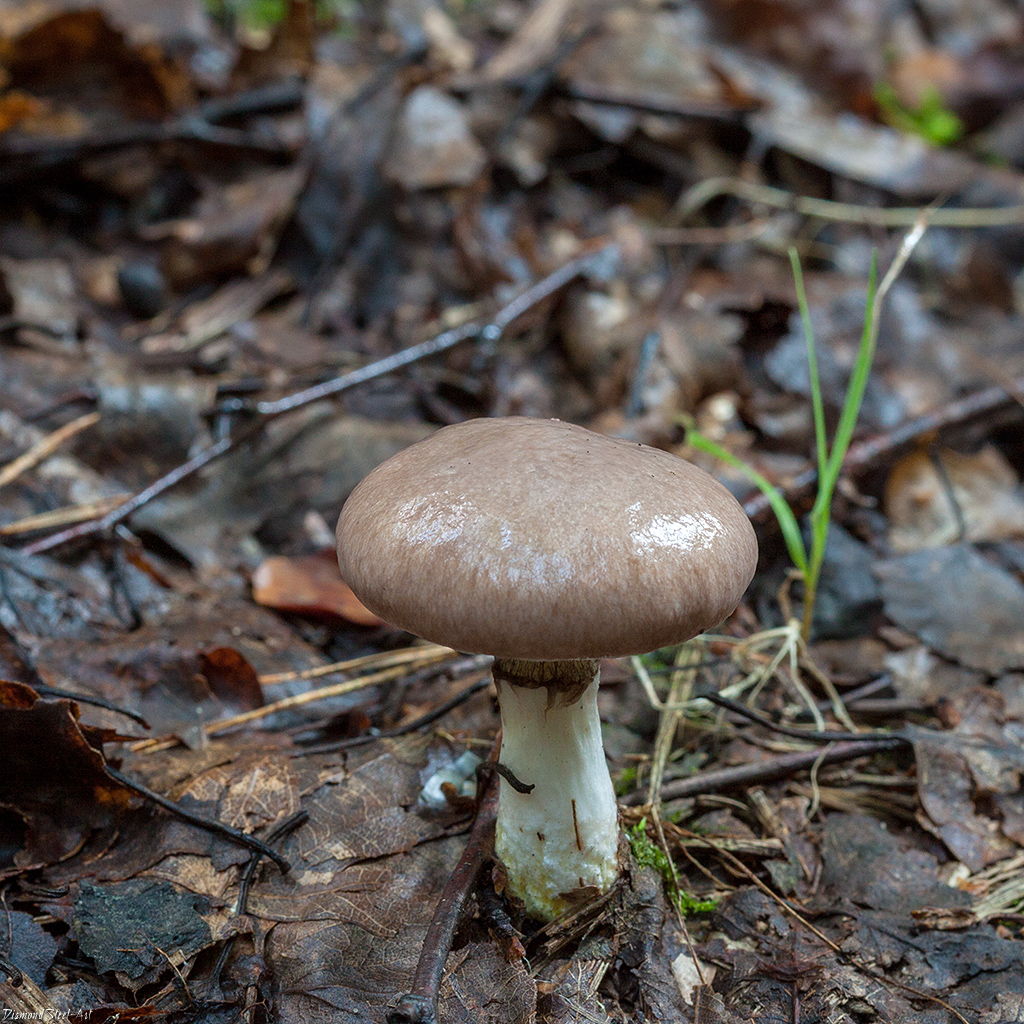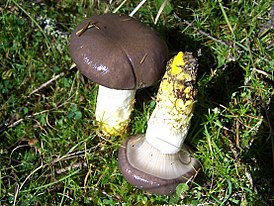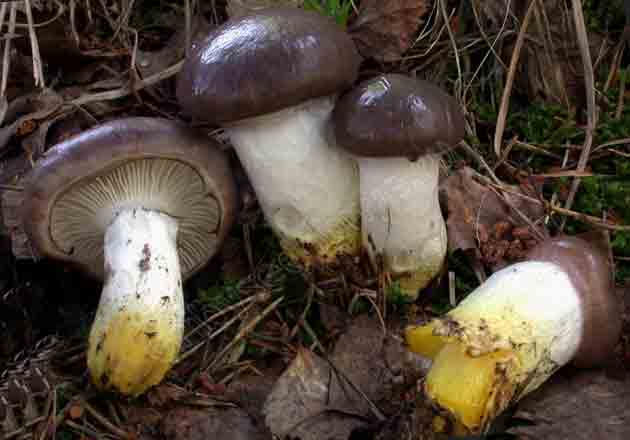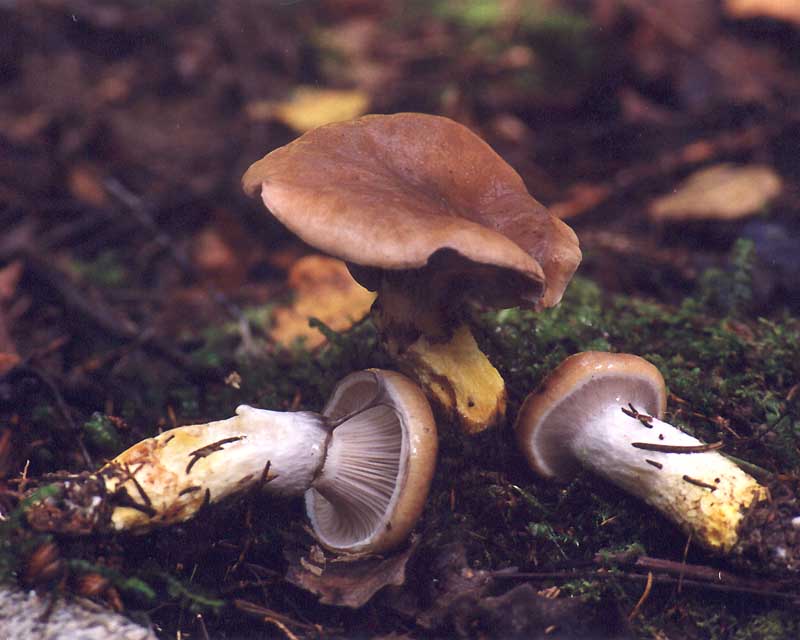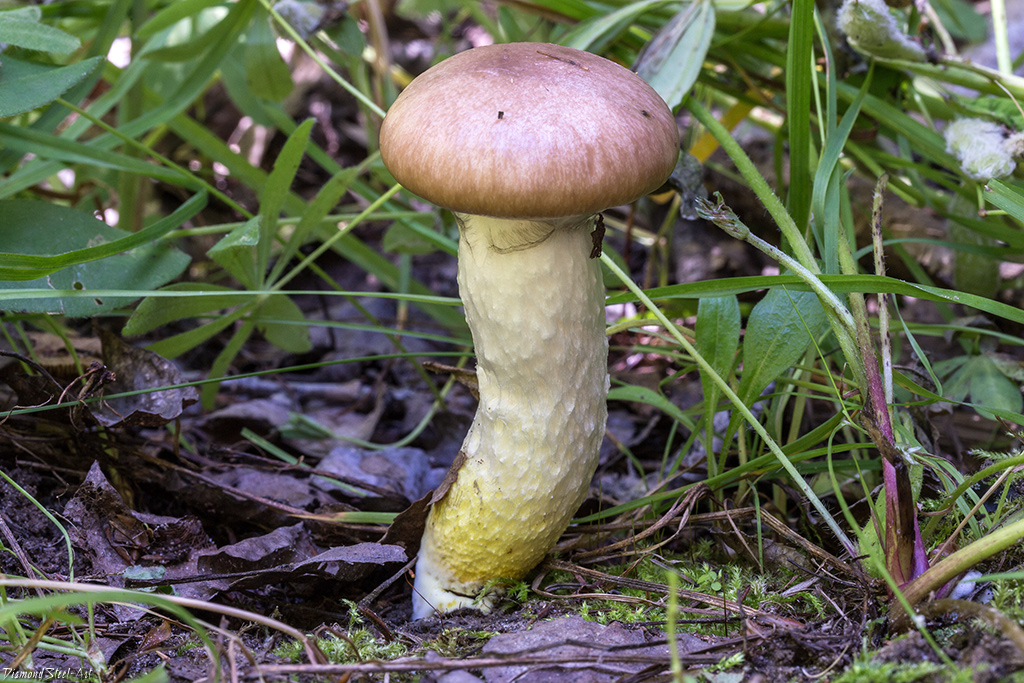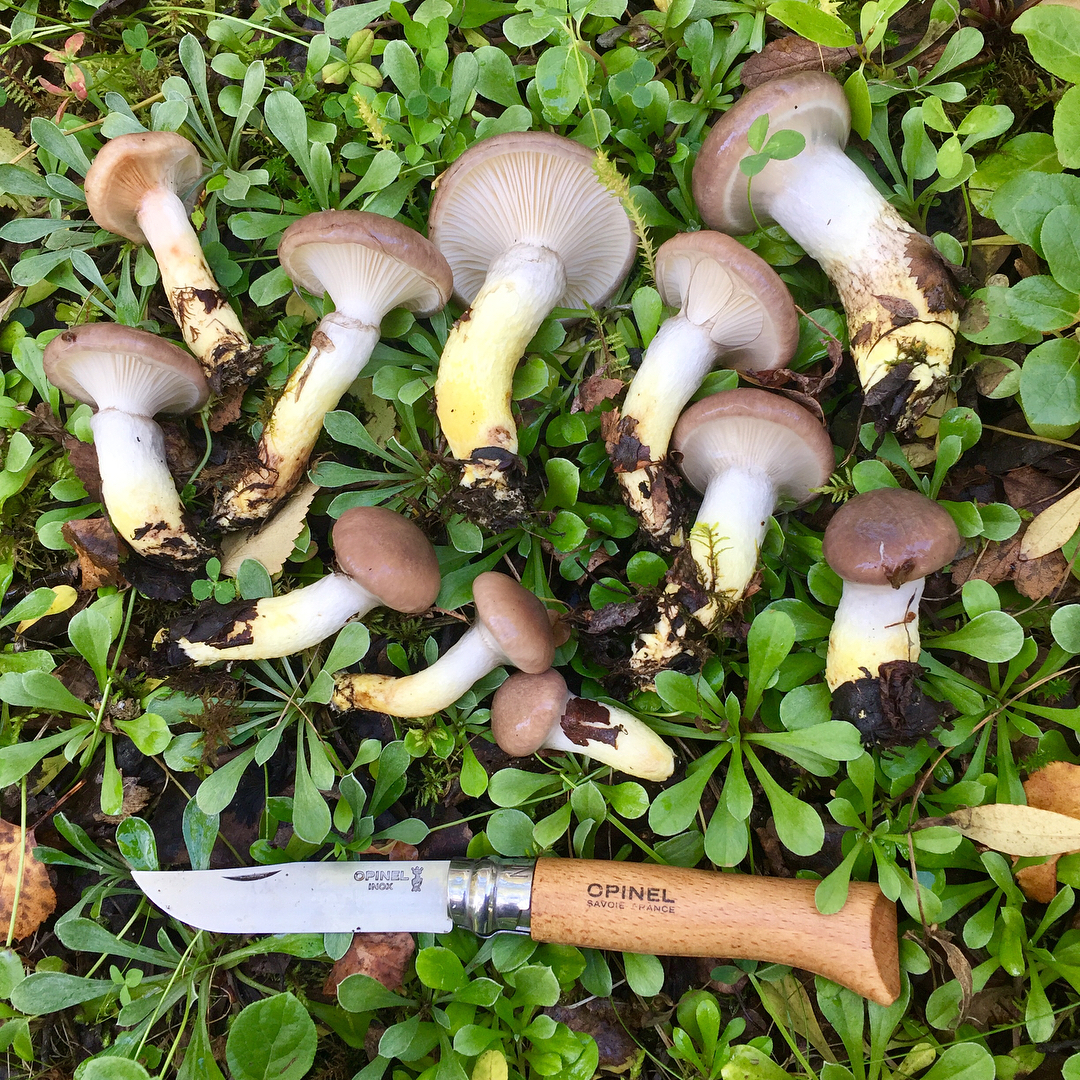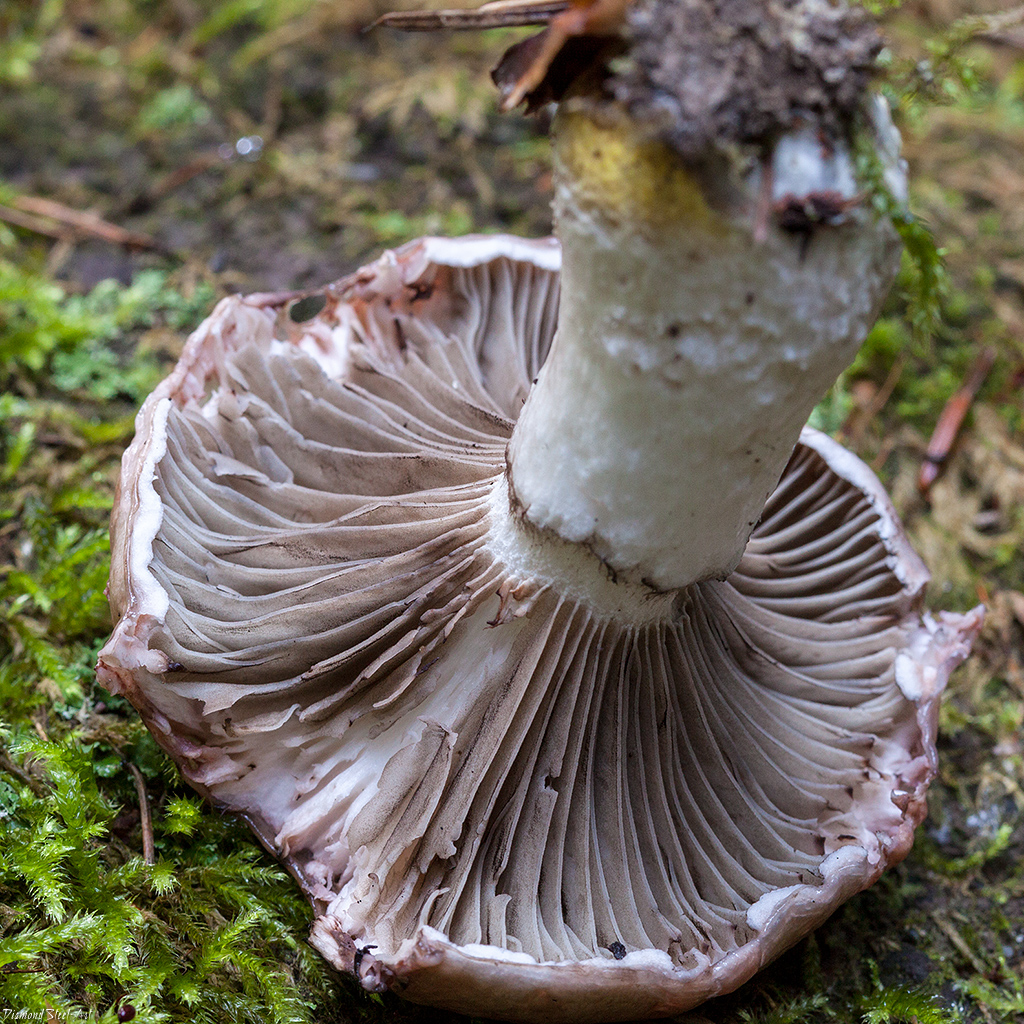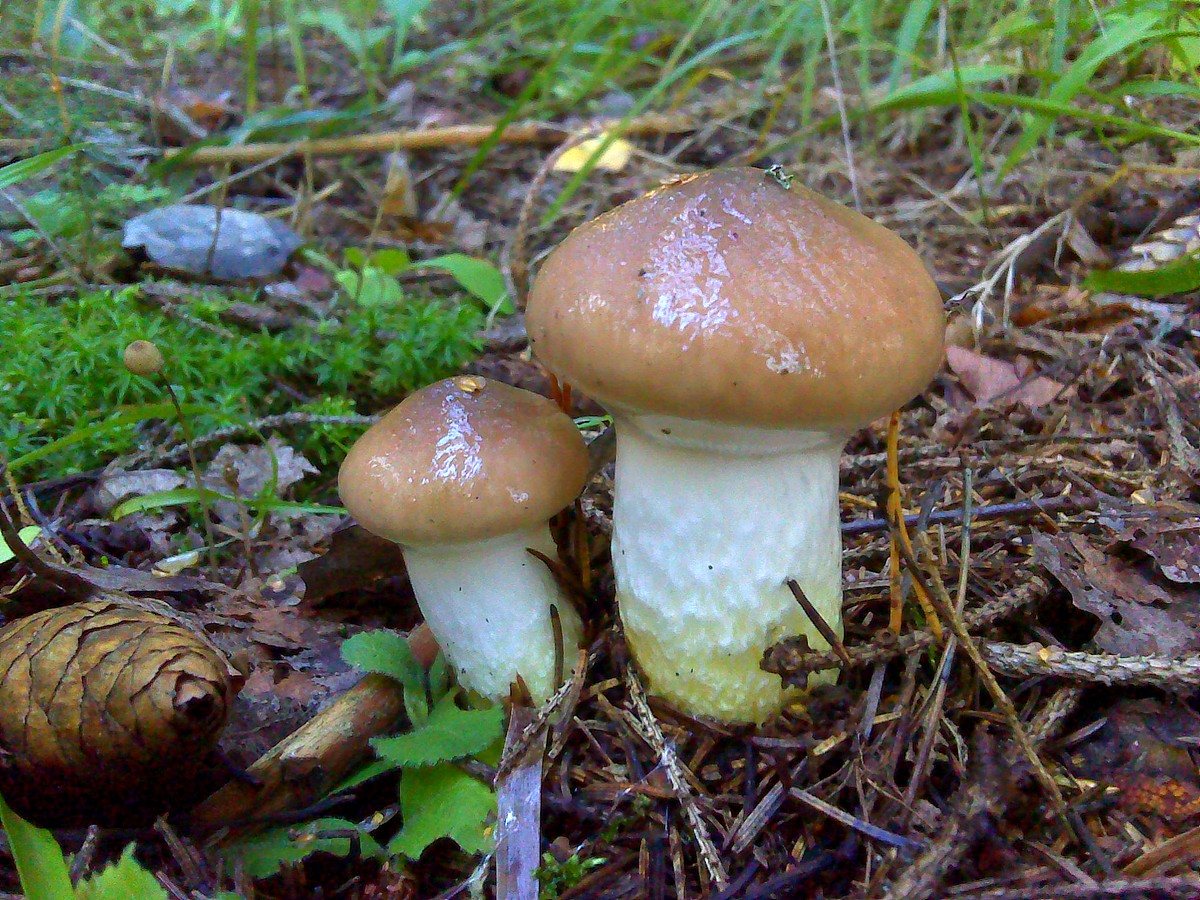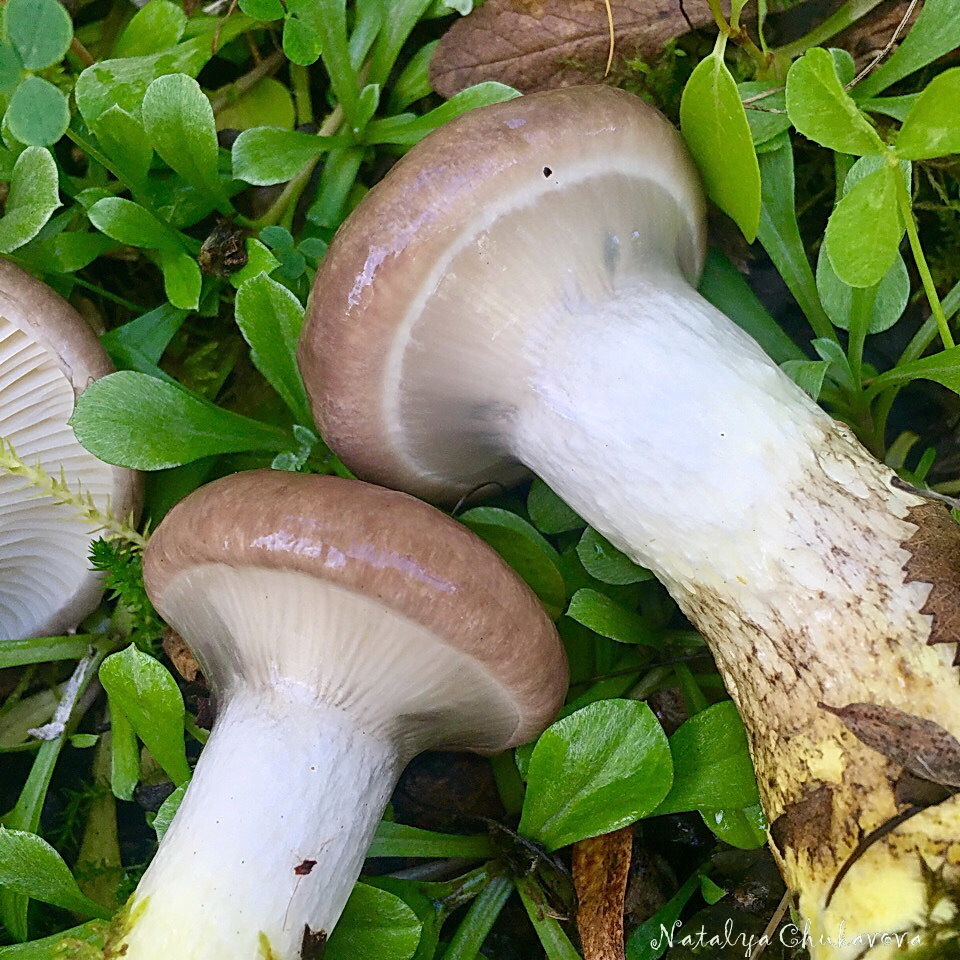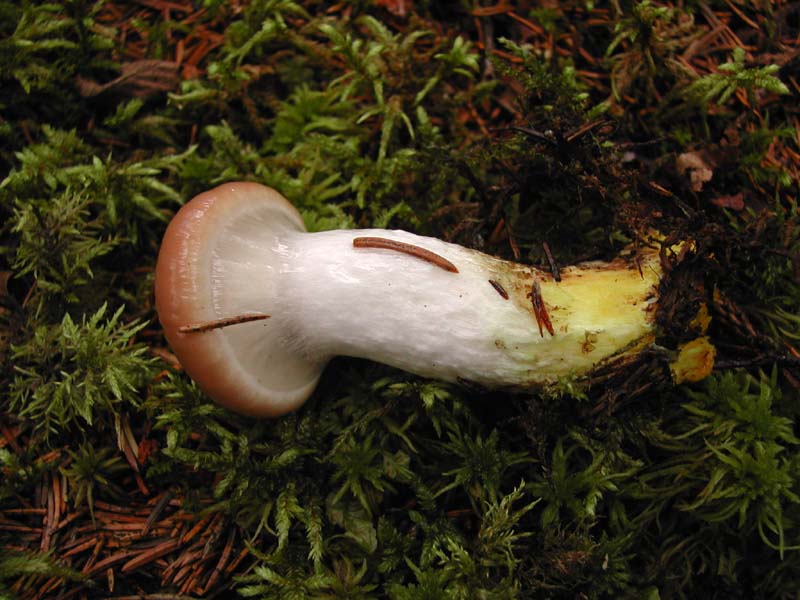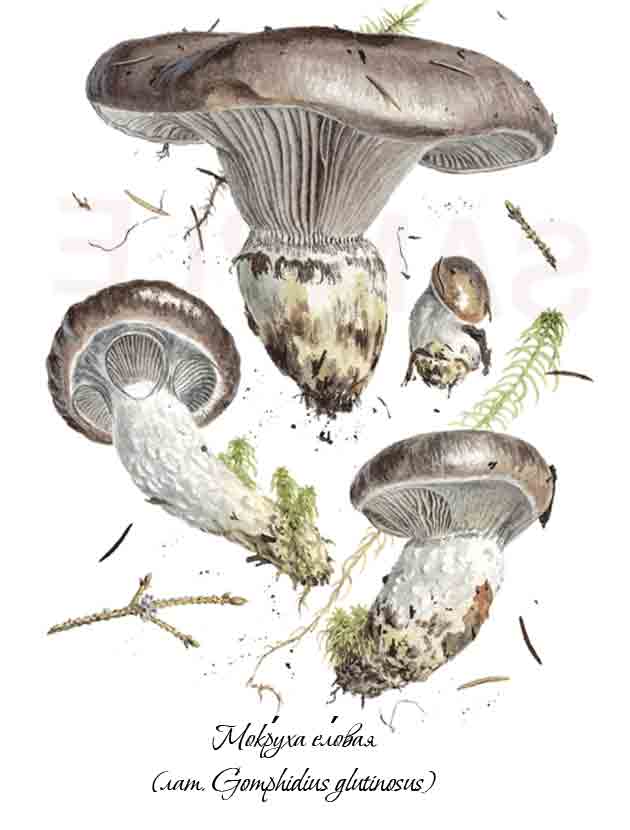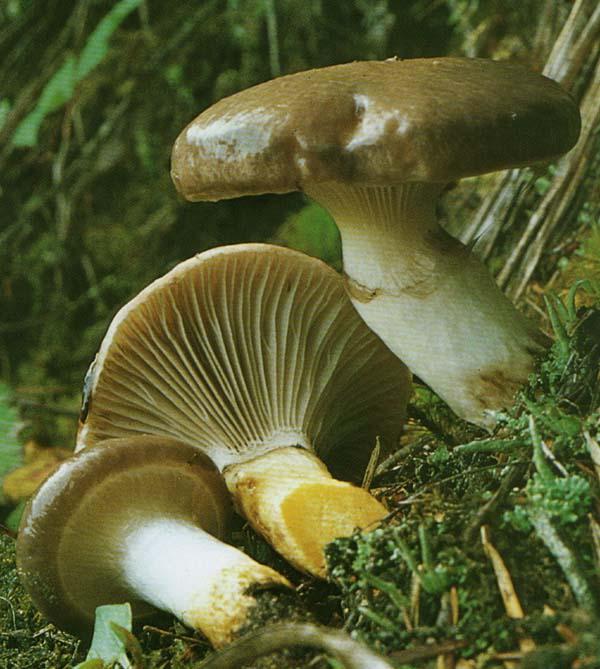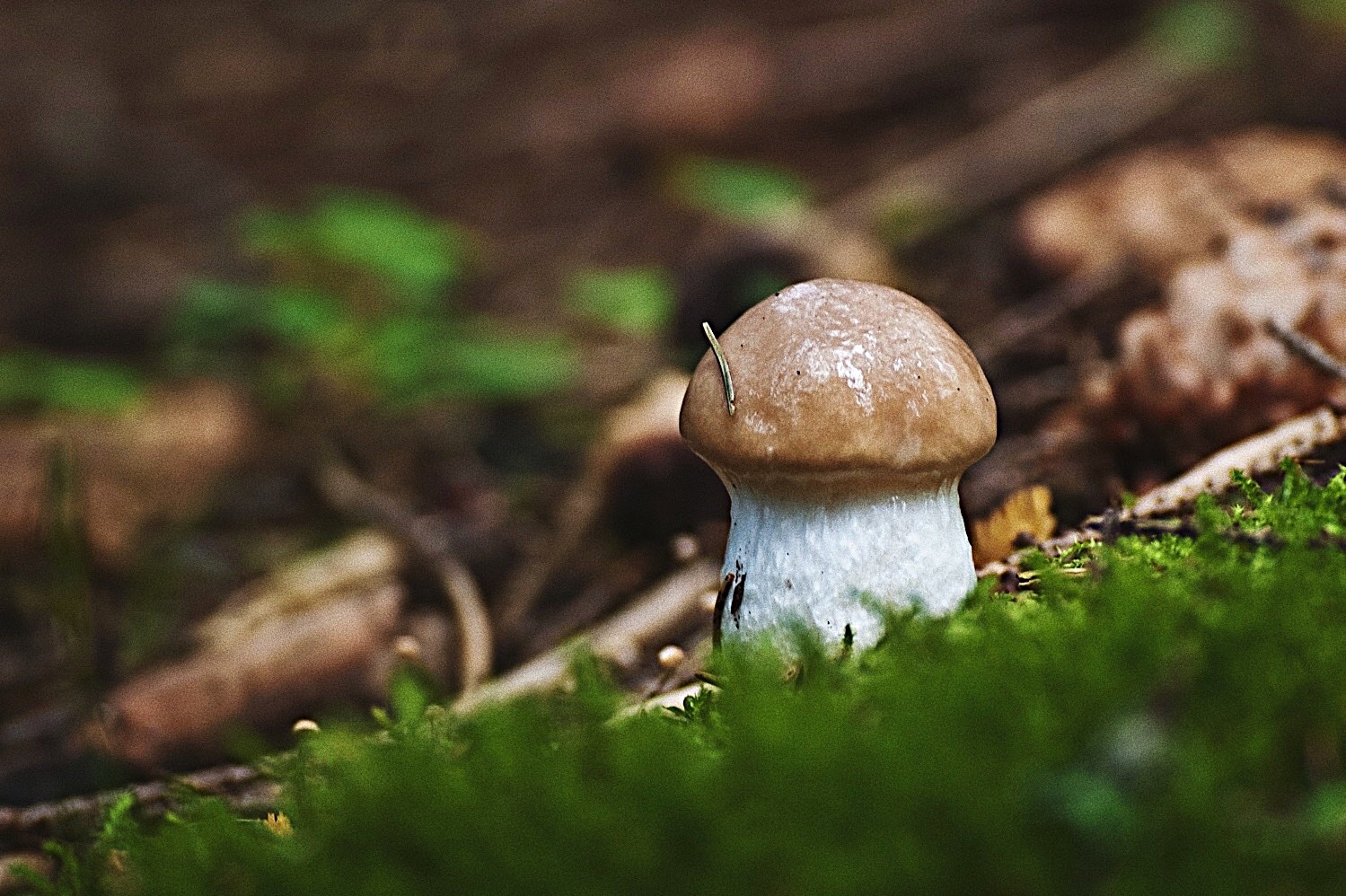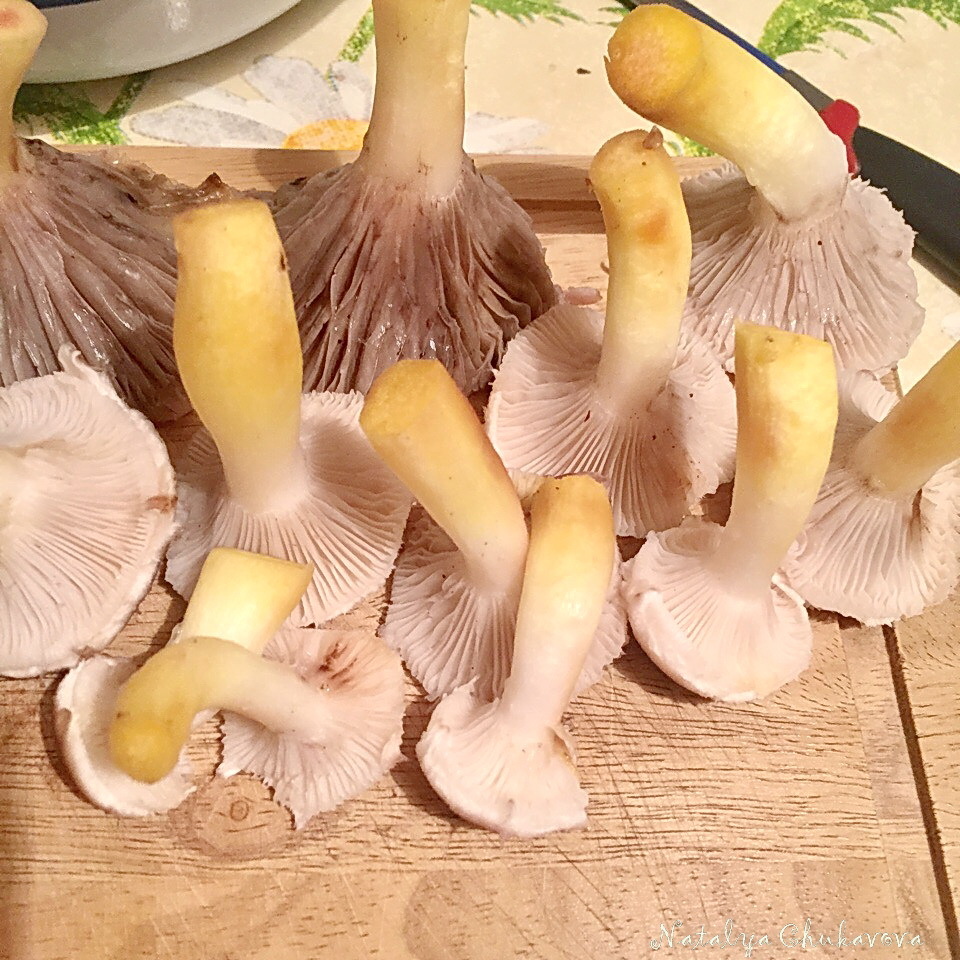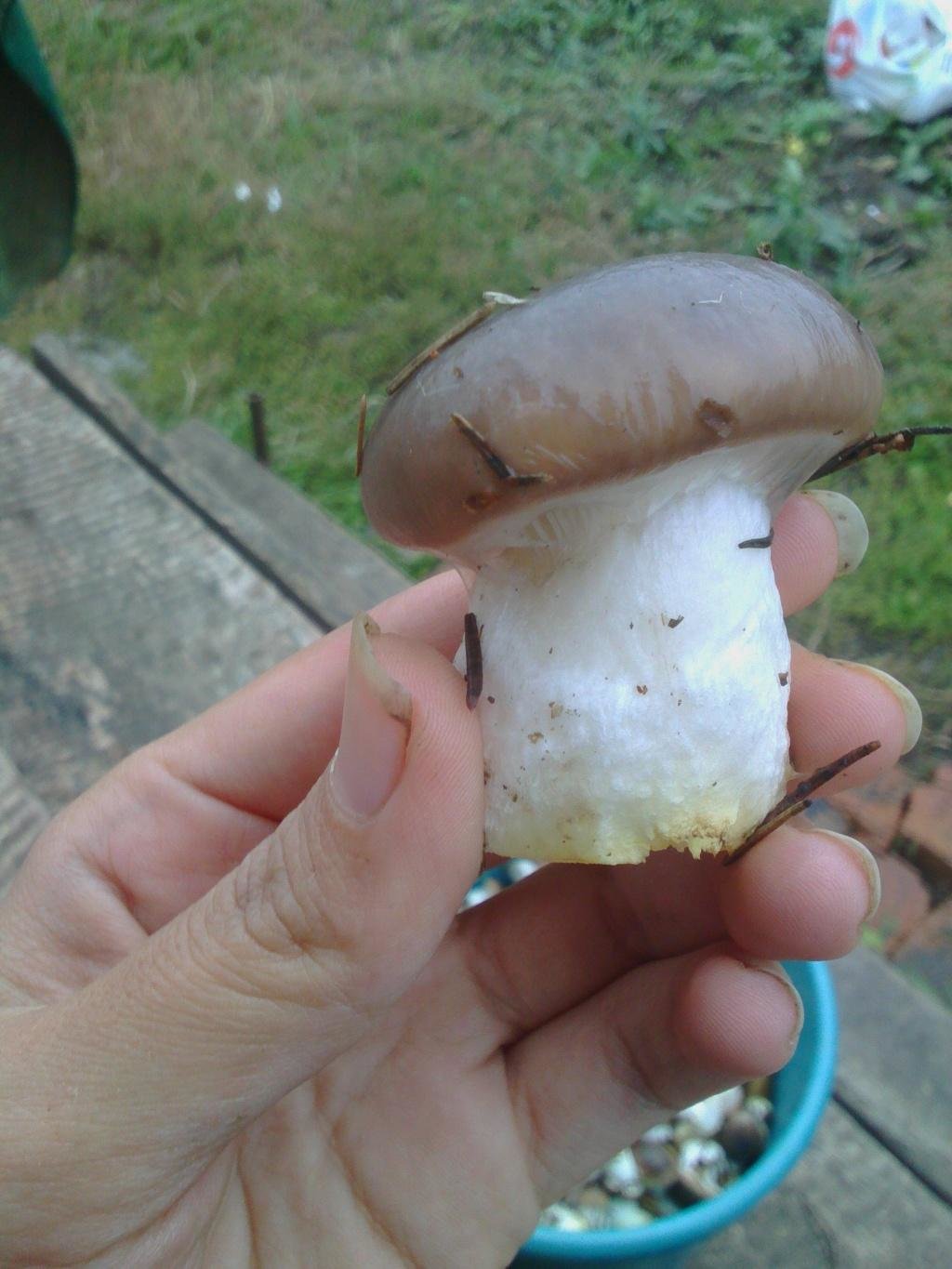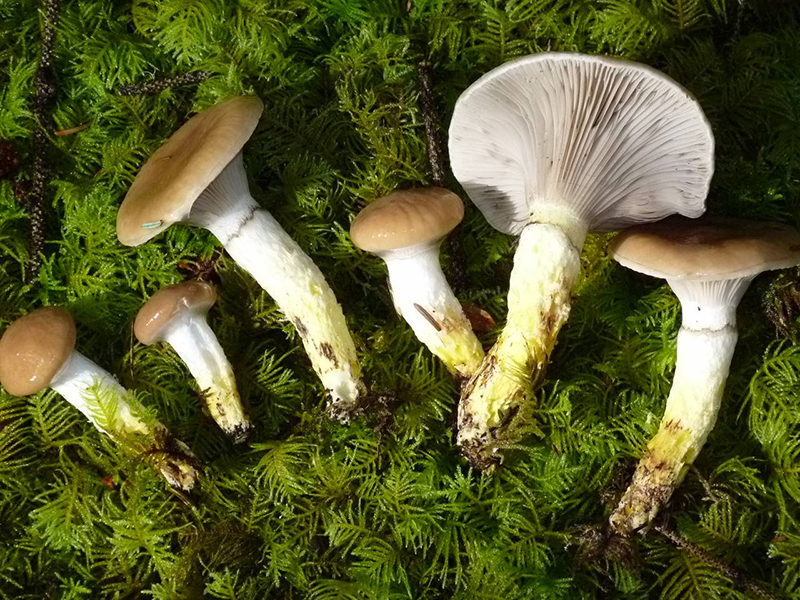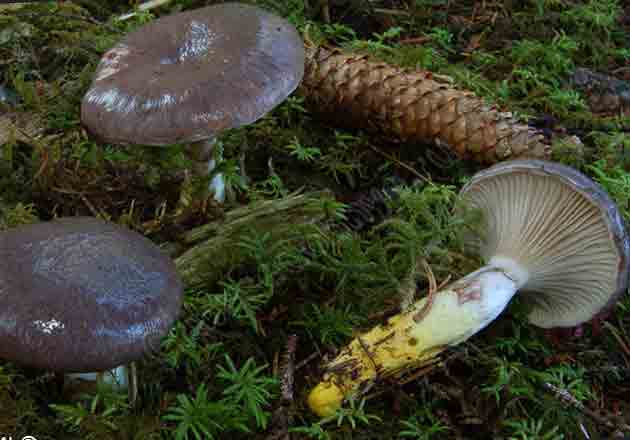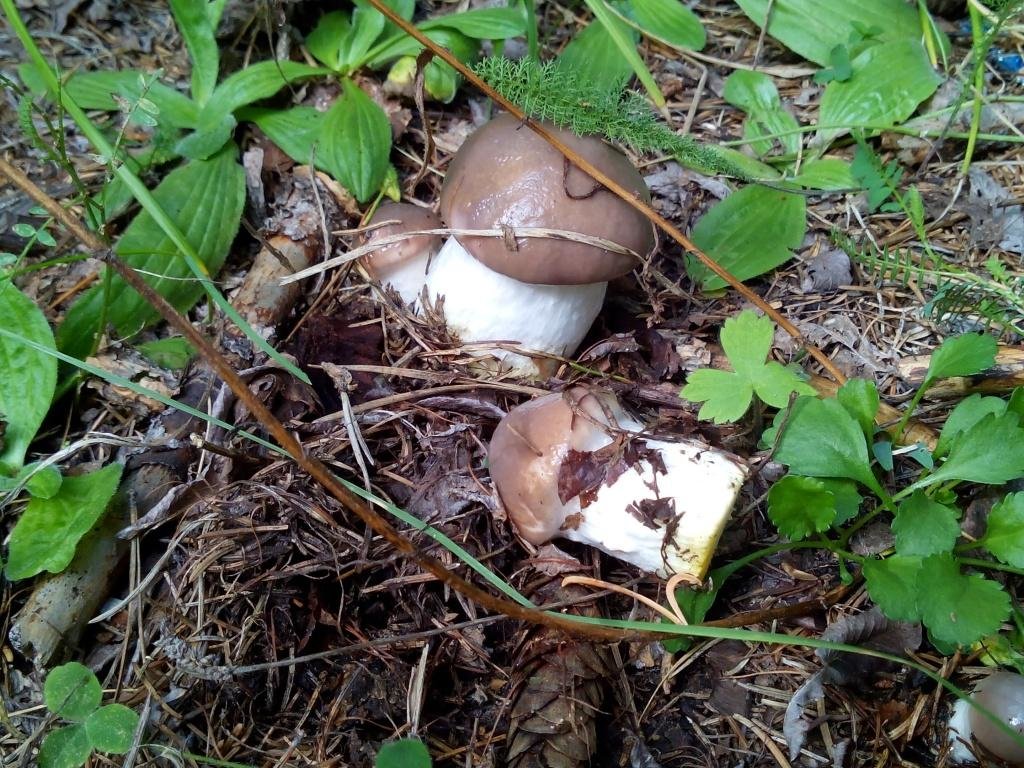Spruce mushroom and its photo
Category: edible.
The hat of spruce moss (Gomphidius glutinosus) (diameter 5-14 cm): grayish or gray-brown, may have dark spots and cast lilac or purple. Fleshy, in young mushrooms it has the shape of a hemisphere, which then changes to almost open, and sometimes slightly depressed. There is usually a small tubercle in the center. The skin is smooth and slimy to the touch, easily separated from the pulp.
Leg (height 4-13 cm): lemon yellow at the very base and grayish at the top. Often covered with scales and darkens with slight pressure.
Pay attention to the photo of spruce moss: a solid and massive cap in young mushrooms is slightly swollen, but over time it becomes cylindrical. As slippery and sticky as a hat
It is connected to it with a transparent mucous blanket, consisting of fibers. In mature mushrooms, it breaks, and its remnants form a mucous ring on the stem.
The plates are white or light gray, with age they become brown, and in old mushrooms they are completely black. Branched and thick, with a characteristic veil.
Flesh: white or pinkish, with age changes to gray and at the very base to yellowish. Has a sour taste and weak aroma.
For the first time the spruce moss mushroom was described by the famous German botanist, mycologist and entomologist Jacob Scheffer in 1774. He attributed this mushroom to the Champignon family (Agaricus) and named Agaricus Glutinosus, which means “molar tooth” in Greek. Another name that is still accepted at the present time, Gomphidius Glutinosus, was received by spruce moss in 1838 thanks to the works of the Swedish scientist Elias Fries.
Doubles: the related edible moss are purple (Chroogomphus rutilus) and spotted (Gomphidius maculatus), and mushrooms with dark caps are similar to common boletus (Suillus luteus). But the pulp of the wet fur at the fracture turns reddened noticeably, and the boletus has no plates.
When it grows: from mid-August to early October in the northern regions of the Eurasian continent.
Where to find it: In mixed and coniferous forests, mostly near spruce and pine trees, often among moss and heather thickets. If you intend to collect different mushrooms, then, in order not to stain them with mucus, determine an isolated place for spruce moss.
Eating: in almost any form, subject to preliminary boiling and removal of the mucous skin from the cap. It is not very popular in Russia, but in Europe it is considered a very tasty mushroom. When pickling or salting, spruce moss darkens a lot. This property does not in the least affect their taste.
Application in traditional medicine (data have not been confirmed and have not undergone clinical studies!): In the form of a tincture as an effective antimicrobial agent.
Other names: sticky moss, slug.
About cooking
Due to its rich mushroom aroma, pleasant taste and fleshy pulp, mokruha is a popular product in cooking. The peculiarity of the mushroom is that heat treatment turns it purple. Hence the name. Primary processing is reduced to washing and peeling.
This species can be both salted and pickled. It will be the perfect base for a tasty broth or sauce.
They also make delicious side dishes in combination with fish dishes or meat side dishes. Often, mokruha is an ingredient in a salad. Due to the purple color of the pulp, the salad looks very unusual.
You need to store fresh moss in the refrigerator for no more than a day. This storage method will allow the product to retain all its nutritional properties.
Mokruha purple and a photo of a mushroom
Category: edible.
The name of the purple moss (Chroogomphus rutilus) literally translates from Latin as "yellow-red", "golden-red".The color of this mokruha is not always purple. And the specific name appeared due to the fact that when exposed to high temperatures, the mushroom becomes exactly purple.
Hat (diameter 4-14 cm): shiny red-brown, brick-red or lilac; in old mushrooms, it usually fades strongly and loses its variegated color. Initially conical, with a central tubercle, over time becomes convex or almost prostrate. Has a brown cover, in a dark and damp place or after rain can be covered with a layer of sticky mucus. The edges are usually curved towards the inside.
Leg (height 4-10 cm): solid and curved, in the shape of a cylinder. Usually the same color as the cap, a little sticky.
If you carefully look at the photo of the purple moss mushroom, you will notice that its arcuate plates are easily separated from the cap. Most often they are purple or purple. In old mushrooms, they become almost black.
Flesh: fleshy, fibrous in the lower part. A yellowish color at the site of the fracture and upon interaction with air changes to pink or red. Has no pronounced smell and taste.
Insect pests are especially fond of purple moss, so it is worth carefully examining the mushroom before putting it in the basket.
Doubles: five edible moss, namely felt (Chroogomphus tomentosus), spruce (Gomphidius glutinosus), Swiss (Chroogomphus helveticus), pink (Gomphidius roseus) and spotted (Gomphidius maculatus). The difference is that the felt cap has a whitish pubescence; spruce, as a rule, grows only next to spruce, and also has a more grayish-gray color; the Swiss cap is ocher and also with a slight felt pubescence. The pink moss has light plates and a bright pink cap, and the spotted one almost always grows under the larch trees.
When it grows: from early August to late September in temperate countries of the Eurasian continent. In Russia, mainly in European territory, less often in Siberia and the North Caucasus.
Where can you find it: on calcareous soils of coniferous and deciduous forests, most often next to pine and birch.
Eating: in any form, provided that the mucous skin is removed from the cap.
Application in traditional medicine: not applicable.
Other names: mucous moss, shiny moss, yellow-legged moss, copper-red yellow legged.
False doubles
Remarkable is the fact that spruce moss has no resemblance to poisonous and inedible mushrooms. She has similar features only with relatives from the Mokrukh family. The difference can be seen in the photo.
Varieties of moss, their differences:
| Part of the mushroom | Mokruha spruce | Mokruha felt | Mokruha spotted | Mokruha pink |
| Hat | It has a grayish color and is a symbiont of conifers. | Covered with slight pubescence. | Grayish color with a brown tint. The pulp at the break tends to turn pink or redden. | Pale or gray-pink, strongly discolored, especially in the center. Quite small with wavy edges. |
| Leg | Lemon yellow at the very base and grayish at the top. Often covered with scales and darkens with slight pressure. | The legs are orange, the caps are olive. | Solid and curved, shaped like a cylinder. Usually the same color as the cap, a little sticky. | Solid, cylindrical. With a slimy ring that becomes thinner and disappears as the fungus matures. |
| Growing period | July-October | September October | Occurs from July to October. | From late July to mid-September. |
Sometimes a slug mushroom is confused with an oiler, but their common features are very conditional, since the latter has no plates under the cap.
Cooking recipes
Spruce mokruha is more popular in Europe than in our region. This mushroom can not only be treated, but also salt, boil, fry, pickle, dry. Soups, second courses with the participation of this species are very tasty.
Primary processing
Before use, fresh mokruh is sorted out, damaged fruits are removed. Experienced lovers of quiet hunting are advised to process the mushroom, removing all the film and mucus. To do this, you need to cut the leg in half lengthwise to the very cap, then cleaning the slippery skin will be very easy.
Cooking
The boiling process is simple. The cleaned fruit bodies are placed in a container with boiling salted water and cooked for 15-20 minutes. If you plan to cook soup, then during cooking you need to constantly remove the resulting foam so that the broth does not darken. Be prepared for the broth to darken - this is typical for preparing mokruh dishes.
Pickling
Housewives advise to pickle this type of mushroom in combination with other representatives of the forest, for example, boletus.
Ingredients:
- slug - 1-2 kg;
- water - 1 l;
- sugar - 80 g;
- salt - 50 g;
- vinegar - 100 ml;
- bay leaf, cloves, peppercorns - 2-3 pcs.
- citric acid - 1 pinch;
- vegetable oil - 1 tbsp. l. / 1 can.
Cooking method:
- Boil the mushrooms in a deep bowl with a pinch of salt and citric acid for 15 minutes.
- Drain the liquid, rinse the fruiting bodies.
- Prepare the marinade: put salt, sugar, spices in 1 liter of water, boil.
- Immerse mushrooms in hot brine, boil for 20 minutes.
- Once all the ingredients have settled to the bottom, you can distribute them to the jars.
- Arrange the mushrooms in sterilized, clean containers, fill with hot marinade so that it completely covers the contents.
- Pour in vegetable oil, cover with a plastic lid. Store these in the refrigerator or cellar.
Freezing
There is nothing difficult in this process. The mokruh boiled in salted water must be thoroughly dried, cut into small pieces, put in plastic containers or in special bags.
Frying
Mokruha spruce does not have a pronounced taste, it actively absorbs the juices of other products, therefore it is recommended to use it as part of other culinary dishes. Fried slugs are also quite tasty, they do not need to be boiled first.
Peel the moss and rinse thoroughly. Cut the fruit bodies into small pieces, place in a frying pan without oil. Cook with the lid closed until all the moisture is gone. Only then pour in the vegetable oil, put the onion cut into rings and fry for another 20-30 minutes.
Salting
Before salting this type of mushroom in a cold way, it does not need to be boiled. Cut the peeled fruit bodies into pieces, put in a container, sprinkle with salt. You can calculate its amount like this: 1 tbsp. a spoonful of salt per 1 kg of mushrooms. Put spices at the bottom of the container: currant and cherry leaves, dill umbrellas, clove buds, lavrushka. Layer everything, place oppression on top. After 2–4 days, if necessary, you can add brine so that it completely covers the product. After a month, the salting will be completely ready for use.
Drying
To keep slugs for a long time, you need to properly prepare them. First of all, it is necessary to remove spoiled, rotten specimens, inspect each fruit body.
Cut the fruit bodies into small pieces and place on a baking sheet. Send the tray to the oven (temperature should be within 50 ° C). It will take about 4 hours to dry the mushrooms. Check the readiness: the piece should be elastic, but not wet.
If you suddenly dry out the moss, it doesn't matter - turn them into powder, from which you can then make an ointment to treat joints.
Canning for the winter
Try making a delicious, flavorful canned mokruh snack. Guests and family will be delighted!
Ingredients:
- slugs - 2 kg;
- salt - 1/2 tbsp. l .;
- garlic - 10 cloves;
- vegetable oil.
Cooking method:
- Boil peeled moss in salted water. Do not forget to constantly skim off the foam during cooking.
- Place the fruit bodies in a colander, dry and cut into small slices.
- Place the mushrooms in a hot skillet (no oil) and cook until the water has completely evaporated.
- Add enough vegetable oil to completely cover the mushrooms. Cook for 40 minutes.
- Chop the garlic, mix it with salt.
- Add the salted garlic mass, stir and cook for another 20 minutes.
- Place the mushroom blank in sterilized jars, fill with hot oil.
- Roll up with metal lids, cool and only then store in a cool place.
Cooking recipes
Spruce mokruha is more popular in Europe than in our region. This mushroom can not only be treated, but also salt, boil, fry, pickle, dry. Soups, second courses with the participation of this species are very tasty.
Primary processing
Before use, fresh mokruh is sorted out, damaged fruits are removed. Experienced lovers of quiet hunting are advised to process the mushroom, removing all the film and mucus. To do this, you need to cut the leg in half lengthwise to the very cap, then cleaning the slippery skin will be very easy.
Cooking
The boiling process is simple. The cleaned fruit bodies are placed in a container with boiling salted water and cooked for 15-20 minutes. If you plan to cook soup, then during cooking you need to constantly remove the resulting foam so that the broth does not darken. Be prepared for the broth to darken - this is typical for preparing mokruh dishes.
Pickling
Housewives advise to pickle this type of mushroom in combination with other representatives of the forest, for example, boletus.
Ingredients:
- slug - 1-2 kg;
- water - 1 l;
- sugar - 80 g;
- salt - 50 g;
- vinegar - 100 ml;
- bay leaf, cloves, peppercorns - 2-3 pcs.
- citric acid - 1 pinch;
- vegetable oil - 1 tbsp. l. / 1 can.
Cooking method:
- Boil the mushrooms in a deep bowl with a pinch of salt and citric acid for 15 minutes.
- Drain the liquid, rinse the fruiting bodies.
- Prepare the marinade: put salt, sugar, spices in 1 liter of water, boil.
- Immerse mushrooms in hot brine, boil for 20 minutes.
- Once all the ingredients have settled to the bottom, you can distribute them to the jars.
- Arrange the mushrooms in sterilized, clean containers, fill with hot marinade so that it completely covers the contents.
- Pour in vegetable oil, cover with a plastic lid. Store these in the refrigerator or cellar.
Freezing
There is nothing difficult in this process. The mokruh boiled in salted water must be thoroughly dried, cut into small pieces, put in plastic containers or in special bags.
Frying
Mokruha spruce does not have a pronounced taste, it actively absorbs the juices of other products, therefore it is recommended to use it as part of other culinary dishes. Fried slugs are also quite tasty, they do not need to be boiled first.
Peel the moss and rinse thoroughly. Cut the fruit bodies into small pieces, place in a frying pan without oil. Cook with the lid closed until all the moisture is gone. Only then pour in the vegetable oil, put the onion cut into rings and fry for another 20-30 minutes.
Salting
Before salting this type of mushroom in a cold way, it does not need to be boiled. Cut the peeled fruit bodies into pieces, put in a container, sprinkle with salt. You can calculate its amount like this: 1 tbsp. a spoonful of salt per 1 kg of mushrooms. Put spices at the bottom of the container: currant and cherry leaves, dill umbrellas, clove buds, lavrushka. Layer everything, place oppression on top. After 2–4 days, if necessary, you can add brine so that it completely covers the product. After a month, the salting will be completely ready for use.
Drying
To keep slugs for a long time, you need to properly prepare them. First of all, it is necessary to remove spoiled, rotten specimens, inspect each fruit body.
Cut the fruit bodies into small pieces and place on a baking sheet. Send the tray to the oven (temperature should be within 50 ° C).It will take about 4 hours to dry the mushrooms. Check the readiness: the piece should be elastic, but not wet.
If you suddenly dry out the moss, it doesn't matter - turn them into powder, from which you can then make an ointment to treat joints.
Canning for the winter
Try making a delicious, flavorful canned mokruh snack. Guests and family will be delighted!
Ingredients:
- slugs - 2 kg;
- salt - 1/2 tbsp. l .;
- garlic - 10 cloves;
- vegetable oil.
Cooking method:
- Boil peeled moss in salted water. Do not forget to constantly skim off the foam during cooking.
- Place the fruit bodies in a colander, dry and cut into small slices.
- Place the mushrooms in a hot skillet (no oil) and cook until the water has completely evaporated.
- Add enough vegetable oil to completely cover the mushrooms. Cook for 40 minutes.
- Chop the garlic, mix it with salt.
- Add the salted garlic mass, stir and cook for another 20 minutes.
- Place the mushroom blank in sterilized jars, fill with hot oil.
- Roll up with metal lids, cool and only then store in a cool place.
Autumn honey agaric, northern form (Armillaria mellea, f. Borealis)
Season: Habitats: Autumn honey agaric, northern form Description of the species:
Autumn honey agaric, northern form Description of the species:
- cap 2-7 cm in diameter, at first round-convex, later prostrate, sometimes with a tubercle in the middle. Distinctive feature of the species: creamy yellow or yellow-brown cap with numerous small brown scales that look like brownish dots. The cap has 2-3 concentric zones, each of which has a predominant color: cream, light brown, yellow-brown, mustard. The edges of the cap are first turned inward, later - straightened; striped. In young specimens, the cap is connected to the stem by a white film, which later hangs in a ring around the stem;
- stalk 4-10 cm high and 5-10 mm thick, dense, cylindrical along its entire length, at first flaky-scaly, later almost glabrous. In the upper part there is a well-defined ring with a fringed edge. The leg is usually exactly the same color as the hat. The second distinctive feature of the species is crowding: mushrooms grow in "clusters", many pieces together. In this case, the legs often grow together at the rhizome;
- the pulp is dense, thin-fleshy, white, does not change color at the break, with a pleasant smell and taste;
- plates are adherent, slightly descending along the pedicle, thin, of medium frequency, whitish-yellowish in young specimens, brownish at maturity, often covered with rusty spots.
Variability: Similarity to inedible species: gray-lamellar falsefoam Edible:
Literature
- The world of plants: in 7 volumes / Ed. Academician A. L. Takhtadzhyan. T.2. Slime molds. Mushrooms - 2nd ed., Rev. - M .: Education, 1991 .-- 475 p. (p. 272).
- Aurel Dermek. Mushrooms. - Bratislava: Slovart, 1989. - pp. 138-139.
- Z. A. Klepina and E. V. Klepina. Handbook of the mushroom picker. - Moscow: AST-PRESS, 2006. - 256 p. (p. 60)
- "Mushrooms. Directory — determinant. More than 120 species "/ Author-compiler N. E. Makarova - Moscow: AST, Minsk: Harvest, 2005—320 p. (pp. 198-199)
- "Mushrooms". Directory. / per. with ital. F. Dvin - Moscow: AST. Astrel, 2004 .-- 303 p. (p. 199)
- Lesso, Thomas. Mushrooms. Determinant. / per. from English - Moscow: AST, 2007 .-- 304 p. (p. 38)
- Serzhanina G.I. Hat mushrooms of Belarus. - Minsk: Science and Technology, 1984.
Description of the types of moss
Six varieties of such mushrooms currently grow on the territory of our country, but the most common are spruce, pink and purple moss.
Spruce peel (sticky)
Gomp.glutinosus is an edible variety characterized by a hemispherical, convex-conical, prostrate or slightly depressed cap in the central part, with the presence of an inconspicuous tubercle.
Also read: Antler mushrooms: a description of the appearance and cooking features
It is characterized by a smooth, pronouncedly slimy, shiny surface of gray, grayish-bluish-blue or grayish-brown skin, which is easily removed from the fleshy and fragile, white or pinkish pulp, which has a slightly sweet or sour taste and an expressionless mushroom aroma. The plates are descending, arcuate, with strong branching, grayish or whitish. The leg is high and massive, with a club-like base, whitish-grayish, mucous, with an unexpressed mucous ring.
Spruce peel (sticky)
Mokrukha purple (yellow-footed)
Chr.rutilus is an edible variety characterized by a conical-rounded, flat-convex or outstretched, with a wide and obtuse elevation in the center with a cap covered with a smooth and shiny, highly slimy, light brown, reddish-brick-red or lilac-reddish skin covering the fleshy, pinkish-yellowish pulp without a strong odor and pronounced taste.
The plates are arcuate, descending, sparsely located, thick, ocher-pink or mauve, purple-brownish or dirty brown, almost black in color. The leg is solid, cylindrical, with a narrowing at the base, slightly sticky, with ring-shaped remains of the bedspread.
Mokrukha purple (yellow-footed)
Mokruha pink
Gomp.roseus - an edible variety, characterized by a hemispherical, convex or flattened, mucous membrane, with tucked or raised edges with a cap of coral pink or brick-pink coloration with rare, descending to the stem, branching, ash-gray and dark grayish tint plates. The leg is cylindrical, narrowed at the base, pinkish-whitish, with a mucous ring. The soft part turns pink at the cut of a whitish color, with a weak and pleasant aroma, as well as a sweetish aftertaste.
Mokruha pink
Mokruha spotted
Gomp.maculatus is an edible variety characterized by a convex, flattened or sometimes slightly depressed cap with curled edges covered with mucous, pale, pink-brownish, grayish-ocher or yellowish skin. Plates are sparsely located, descending type, branched, whitish or dirty brown in color. The stem is cylindrical, fibrous type, with an adhesive surface and a mucous ring. The soft part is whitish or yellowish, reddening at the cut.
Mokruha spotted
Mokruha felt
Chr.tomentosus is an edible variety, characterized by a convex, flattened and sometimes depressed, with a blunt tubercle in the center and pubescent, curled edges of the cap, covered with a dry, fibrous, slightly sticky, yellowish-brown or ocher skin. Plates are rare, descending type, dirty brown in color. The leg is cylindrical, fibrous type, with the presence of a cobweb ring. The soft part of the ocher color, with a wine-pink tint.
Also read: Summer mushrooms: description and places of growth of mushrooms
Cooking use. Recipes
In Europe, spruce mokruha is considered a tasty product, and in China it is consumed more often than other mushrooms, in our country it is not very popular. Gummy moss can be salted, fried and pickled. It is also suitable for drying. Soups, sauces, casseroles, sandwiches are made from it. Spruce bark can be added to salads fried or boiled. It will give the dish a special taste and make it visually attractive.
It is preferred to be used as an addition to main dishes, mixed with other mushrooms. It goes well with meat or fish if fried or stewed with other more flavorful foods.
Before use, freshly picked moss are sorted out, damaged mushrooms are discarded. It is advised to remove all film and mucus. To do this, you need to cut the leg in half lengthwise to the very cap, then it will be very easy to remove the unnecessary skin.
Mushroom pickers recommend putting mushrooms in water for a few minutes before cleaning. Then the mucus layer will be removed even more easily. Fingers darken during cleaning, but after the procedure they are easily washed with soap and water. Then the mushrooms are washed and boiled for about 15-20 minutes. After heat treatment, the product darkens, this color change does not affect the taste of the product.
If the mushrooms are fried, then a lot of oil is not added, because the pulp will give juice, which is enough for further processing. For lovers of crispy and strong mushrooms after frying, mokruh is not suitable. It is not worth extinguishing sticky mokruh for too long, because the pulp will become tough.
How to pickle Mokrukha
Mushroom pickers advise marinating slugs along with other mushrooms. So, for 1 wet fur there are 8-10 boletus or cobwebs.
The following pickling recipe has proven itself well:
- The peeled mushrooms must be folded into a deep container and filled with water, adding a pinch of salt and the same amount of citric acid. The composition is brought to a boil and cooked for 15-20 minutes.
- The water is drained and the mushrooms are washed. They are now ready to marinate.
- 1 liter of water is poured into a saucepan and 80 g of sugar, 5 black peppercorns, 2 cloves, 50 g of salt, 100 ml of 6% vinegar and one laurel leaf are added.
- The resulting marinade is brought to a boil and 2 kg of prepared mushrooms are added to it. All are cooked together for 20 minutes.
- When the mushrooms sink to the bottom, and the water becomes clear, they are transferred together with the marinade into pre-prepared jars, pouring liquid so that it completely covers the moss with oily oils.
- Add 1 tablespoon of sunflower oil to each jar and close with nylon caps. Store pickled mushrooms in the refrigerator.
Below are other recipes with wet gummy:
Korean snack
Very fast and delicious.
To prepare this dish, you need to carefully separate the mushrooms from the film and boil. Then the mushrooms are fried along with chopped onions.
Korean carrots are added to the finished products, preferably not spicy. The dish is seasoned with olive oil.
Pepper stuffed with mushrooms and buckwheat
Most housewives are used to stuffing bell peppers with rice and meat. You can diversify the menu by replacing the filling with buckwheat and spruce mokrukh. To do this, you need to boil and fry the mushrooms a little. Then they should be mixed with raw buckwheat, salt and pepper to taste. The resulting composition is stuffed with peppers, which must be cleared of seeds in advance. Vegetables are stewed in water with the addition of tomato paste, or in fresh tomatoes.
Bachelor sandwiches
This is a very simple recipe that even a child can handle. It is necessary to fry a few slices of bread and spread a little butter on them. The peeled mushrooms are boiled and fried in a pan for 3-4 minutes. Fried mokruh is placed on the bread and sprinkled with grated cheese and herbs on top. Sandwiches need to be sent to the microwave for 1-2 minutes to melt the cheese.
Due to its low calorie content and a large amount of nutrients contained in this product, nutritionists recommend spruce moss for daily use. In terms of protein content, it can become a good competitor to meat dishes.


